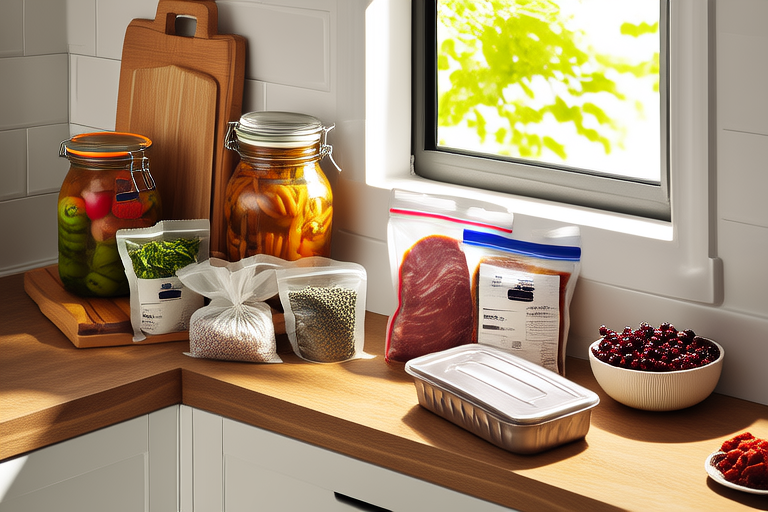Introduction: Why Food Preservation Matters
Food preservation is an essential skill that not only helps in extending the shelf life of your meals but also ensures that you make the most out of your groceries. In today’s world, where sustainability and cost-effectiveness are increasingly important, knowing how to preserve food can save you money and reduce waste. This guide will walk you through various techniques to keep your meals fresh longer, whether you’re a beginner or an experienced cook.
Understanding Different Preservation Methods
1. Canning: A Time-Honored Technique
Canning is one of the oldest methods of preserving food. It involves sealing food in airtight containers, usually jars, and processing them in boiling water or steam to kill any microorganisms. Once sealed, the jars can be stored at room temperature for extended periods. Common foods preserved by canning include fruits, vegetables, jams, and sauces.
Steps to Canning:
- Prepare clean jars and lids.
- Sterilize the jars and lids by boiling them.
- Pack the food into the jars, leaving appropriate headspace.
- Process the filled jars in a boiling water bath or pressure canner.
- Seal the jars tightly and allow them to cool.
2. Freezing: Simple and Effective
Freezing is another popular method that slows down the growth of bacteria and enzymes, thus preserving the quality of food. It’s particularly effective for perishable items like meat, fish, and vegetables. However, it’s important to note that freezing doesn’t kill all bacteria, so proper handling is crucial.
Tips for Freezing:
- Use airtight containers or freezer bags.
- Label packages with the date and contents.
- Freeze food as soon as possible after purchase or preparation.
- Thaw frozen food in the refrigerator, not at room temperature.
3. Dehydrating: Nature’s Way of Preserving
Dehydrating removes moisture from food, making it less hospitable for bacteria and fungi. This method is great for fruits, vegetables, and herbs. Dehydrated food can be stored for months without refrigeration and is perfect for camping or hiking trips.
How to Dehydrate:
- Choose fresh, ripe produce.
- Wash and slice the food into uniform pieces.
- Arrange the slices on dehydrator trays.
- Set the dehydrator to the recommended temperature (usually around 135°F).
- Check periodically until the food is dry and leathery.
4. Pickling: Adding Flavor and Longevity
Pickling involves immersing food in an acidic solution, typically vinegar or brine, which inhibits bacterial growth. Pickled vegetables, fruits, and even meats can last for several months when stored properly. This method not only preserves food but also adds a unique flavor profile to your dishes.
Basic Pickling Steps:
- Select fresh, crisp vegetables or fruits.
- Prepare a brine solution using vinegar, salt, sugar, and spices.
- Submerge the food in the brine.
- Store in airtight jars in the refrigerator.
Practical Tips and Case Studies
Case Study: Extending Fresh Produce Shelf Life
Imagine you’ve just bought a large batch of seasonal berries. Instead of letting them spoil, you decide to freeze them. Here’s how:
Preparation:
Rinse the berries gently under cold water and pat them dry.
Portion Control:
Spread the berries on a baking sheet lined with parchment paper.
Freezing:
Place the tray in the freezer for about 2 hours until the berries are firm.
Storage:
Transfer the frozen berries to a freezer bag or container, seal it tightly, and return it to the freezer.
This simple process allows you to enjoy fresh-tasting berries well beyond their usual shelf life.
Actionable List: Quick Tips for Beginners
- Label Everything: Always label your preserved foods with dates to track freshness.
- Use Quality Ingredients: Start with high-quality, fresh ingredients for better results.
- Cleanliness is Key: Ensure all equipment and surfaces are clean to prevent contamination.
- Experiment Gradually: Try one method at a time to build confidence before moving on to more complex techniques.
Conclusion: Embrace Preservation for a Healthier Lifestyle
In summary, mastering food preservation techniques can significantly enhance your culinary skills while promoting a more sustainable lifestyle. By choosing the right method for each type of food, you can extend the shelf life of your meals, reduce waste, and save money. Whether you’re a novice or an experienced chef, incorporating these practices into your routine will lead to healthier, more flavorful meals.
Action Step:
Start small by trying one new preservation technique each month. Experiment with different recipes and methods to find what works best for you. With practice, you’ll become proficient in keeping your pantry stocked with delicious, long-lasting meals.
